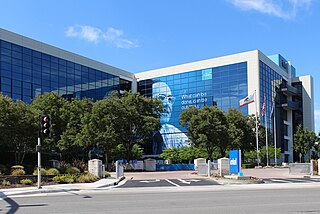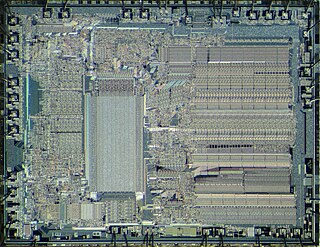Stephen Paul Morse (born May 1940) is the architect of the Intel 8086 chip [1] and is the originator of the "One Step" search page tools used by genealogists.
Morse was born in Brooklyn, New York. He has degrees in electrical engineering from the City College of New York, the Polytechnic Institute of Brooklyn and New York University.
Morse worked for Bell Laboratories, IBM's Watson Research Center, Intel, and General Electric Corporate Research and Development. He was a principal architect of Intel 8086 microprocessor chip, designed by Intel between early 1976 and June 8, 1978.
He is quoted as saying:
"While I'd like to think that the PC wouldn't exist today if I hadn't designed the 8086, the reality is that it would be based on some other processor family. The instruction set would be radically different, but there would still be a PC. I was just fortunate enough to be at the right place at the right time." [2]
In the early 2000s, [2] he has applied his technology expertise to web-based genealogy search tools. His "One Step" search pages are widely used by genealogists all over the world. He is also a co-author, with linguist Alexander Beider, of the Beider–Morse phonetic name matching algorithm. [3] [4]

Intel Corporation is an American multinational corporation and technology company headquartered in Santa Clara, California, and incorporated in Delaware. Intel designs, manufactures and sells computer components and related products for business and consumer markets. It is considered one of the world's largest semiconductor chip manufacturers by revenue and ranked in the Fortune 500 list of the largest United States corporations by revenue for nearly a decade, from 2007 to 2016 fiscal years, until it was removed from the ranking in 2018. In 2020, it was reinstated and ranked 45th, being the 7th-largest technology company in the ranking.

The Intel 80286 is a 16-bit microprocessor that was introduced on February 1, 1982. It was the first 8086-based CPU with separate, non-multiplexed address and data buses and also the first with memory management and wide protection abilities. The 80286 used approximately 134,000 transistors in its original nMOS (HMOS) incarnation and, just like the contemporary 80186, it can correctly execute most software written for the earlier Intel 8086 and 8088 processors.

The Intel 8080 ("eighty-eighty") is the second 8-bit microprocessor designed and manufactured by Intel. It first appeared in April 1974 and is an extended and enhanced variant of the earlier 8008 design, although without binary compatibility. The initial specified clock rate or frequency limit was 2 MHz, with common instructions using 4, 5, 7, 10, or 11 clock cycles. As a result, the processor is able to execute several hundred thousand instructions per second. Two faster variants, the 8080A-1 and 8080A-2, became available later with clock frequency limits of 3.125 MHz and 2.63 MHz respectively. The 8080 needs two support chips to function in most applications: the i8224 clock generator/driver and the i8228 bus controller. The 8080 is implemented in N-type metal–oxide–semiconductor logic (NMOS) using non-saturated enhancement mode transistors as loads thus demanding a +12 V and a −5 V voltage in addition to the main transistor–transistor logic (TTL) compatible +5 V.

The 8086 is a 16-bit microprocessor chip designed by Intel between early 1976 and June 8, 1978, when it was released. The Intel 8088, released July 1, 1979, is a slightly modified chip with an external 8-bit data bus, and is notable as the processor used in the original IBM PC design.

The Intel 8088 microprocessor is a variant of the Intel 8086. Introduced on June 1, 1979, the 8088 has an eight-bit external data bus instead of the 16-bit bus of the 8086. The 16-bit registers and the one megabyte address range are unchanged, however. In fact, according to the Intel documentation, the 8086 and 8088 have the same execution unit (EU)—only the bus interface unit (BIU) is different. The 8088 was used in the original IBM PC and in IBM PC compatible clones.

The Intel 386, originally released as 80386 and later renamed i386, is a 32-bit microprocessor designed by Intel. The first pre-production samples of the 386 were released to select developers in 1985, while mass production commenced in 1986. The processor was a significant evolution in the x86 architecture, extending a long line of processors that stretched back to the Intel 8008. The 386 was the central processing unit (CPU) of many workstations and high-end personal computers of the time. The 386 began to fall out of public use starting with the release of the i486 processor in 1989, while in embedded systems the 386 remained in widespread use until Intel finally discontinued it in 2007.

The Intel 80186, also known as the iAPX 186, or just 186, is a microprocessor and microcontroller introduced in 1982. It was based on the Intel 8086 and, like it, had a 16-bit external data bus multiplexed with a 20-bit address bus.

The Pentium FDIV bug is a hardware bug affecting the floating-point unit (FPU) of the early Intel Pentium processors. Because of the bug, the processor would return incorrect binary floating point results when dividing certain pairs of high-precision numbers. The bug was discovered in 1994 by Thomas R. Nicely, a professor of mathematics at Lynchburg College. Missing values in a lookup table used by the FPU's floating-point division algorithm led to calculations acquiring small errors. While these errors would in most use-cases only occur rarely and result in small deviations from the correct output values, in certain circumstances the errors can occur frequently and lead to more significant deviations.

The Pentium is a x86 microprocessor introduced by Intel on March 22, 1993. It is the first CPU using the Pentium brand. Considered the fifth generation in the 8086 compatible line of processors, its implementation and microarchitecture was internally called P5.

x86 is a family of complex instruction set computer (CISC) instruction set architectures initially developed by Intel based on the 8086 microprocessor and its 8-bit-external-bus variant, the 8088. The 8086 was introduced in 1978 as a fully 16-bit extension of 8-bit Intel's 8080 microprocessor, with memory segmentation as a solution for addressing more memory than can be covered by a plain 16-bit address. The term "x86" came into being because the names of several successors to Intel's 8086 processor end in "86", including the 80186, 80286, 80386 and 80486. Colloquially, their names were "186", "286", "386" and "486".

The iAPX 432 is a discontinued computer architecture introduced in 1981. It was Intel's first 32-bit processor design. The main processor of the architecture, the general data processor, is implemented as a set of two separate integrated circuits, due to technical limitations at the time. Although some early 8086, 80186 and 80286-based systems and manuals also used the iAPX prefix for marketing reasons, the iAPX 432 and the 8086 processor lines are completely separate designs with completely different instruction sets.
Soundex is a phonetic algorithm for indexing names by sound, as pronounced in English. The goal is for homophones to be encoded to the same representation so that they can be matched despite minor differences in spelling. The algorithm mainly encodes consonants; a vowel will not be encoded unless it is the first letter. Soundex is the most widely known of all phonetic algorithms Improvements to Soundex are the basis for many modern phonetic algorithms.

The Intel 8087, announced in 1980, was the first floating-point coprocessor for the 8086 line of microprocessors. The purpose of the chip was to speed up floating-point arithmetic operations, such as addition, subtraction, multiplication, division, and square root. It also computes transcendental functions such as exponential, logarithmic or trigonometric calculations. The performance enhancements were from approximately 20% to over 500%, depending on the specific application. The 8087 could perform about 50,000 FLOPS using around 2.4 watts.
Genetic genealogy is the use of genealogical DNA tests, i.e., DNA profiling and DNA testing, in combination with traditional genealogical methods, to infer genetic relationships between individuals. This application of genetics came to be used by family historians in the 21st century, as DNA tests became affordable. The tests have been promoted by amateur groups, such as surname study groups or regional genealogical groups, as well as research projects such as the Genographic Project.
Daitch–Mokotoff Soundex is a phonetic algorithm invented in 1985 by Jewish genealogists Gary Mokotoff and Randy Daitch. It is a refinement of the Russell and American Soundex algorithms designed to allow greater accuracy in matching of Slavic and Yiddish surnames with similar pronunciation but differences in spelling.
A source-to-source translator, source-to-source compiler, transcompiler, or transpiler is a type of translator that takes the source code of a program written in a programming language as its input and produces an equivalent source code in the same or a different programming language. A source-to-source translator converts between programming languages that operate at approximately the same level of abstraction, while a traditional compiler translates from a higher level programming language to a lower level programming language. For example, a source-to-source translator may perform a translation of a program from Python to JavaScript, while a traditional compiler translates from a language like C to assembly or Java to bytecode. An automatic parallelizing compiler will frequently take in a high level language program as an input and then transform the code and annotate it with parallel code annotations or language constructs.

JewishGen is a non-profit organization founded in 1987 as an international electronic resource for Jewish genealogy. In 2003, JewishGen became an affiliate of the Museum of Jewish Heritage – A Living Memorial to the Holocaust in New York City. It provides amateur and professional genealogists with the tools to research their Jewish family history and heritage.

Megan Smolenyak Smolenyak, born October 9, is an American genealogist, author, and speaker. She is also a consultant for the FBI and NCIS.

Alexander Beider is the author of reference books in the field of Jewish onomastics and the linguistic history of Yiddish.
Steven, Stephen, or Steve Morse may refer to: